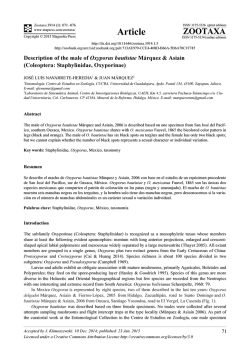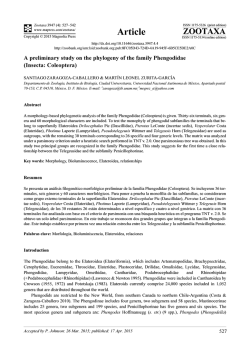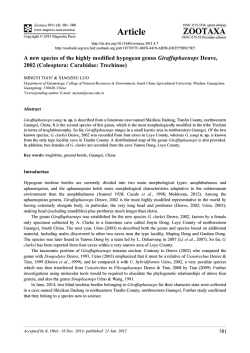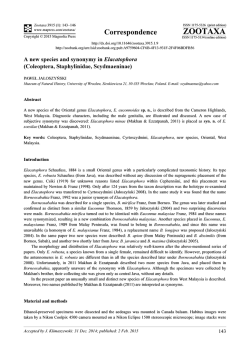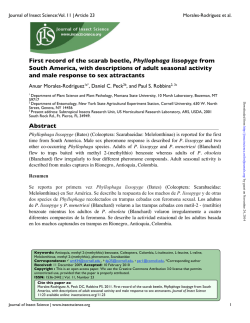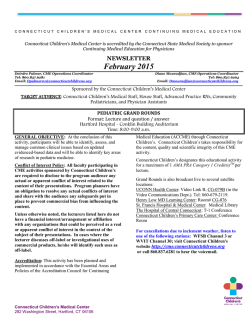
NOTA / NOTE
ISSN: 1989-6581 Ferreira (2015) www.aegaweb.com/arquivos_entomoloxicos ARQUIVOS ENTOMOLÓXICOS, 13: 215-218 NOTA / NOTE Three cases of symphysocery in Coleoptera (Cerambycidae, Chrysomelidae and Tenebrionidae) from Connecticut, U.S.A. Raul Nascimento Ferreira 6 Fairview Dr., Pawcatuck CT 06379-1223, U.S.A. e-mail: [email protected] Abstract: Three cases of symphysocery in Coleoptera (Cerambycidae, Chrysomelidae and Tenebrionidae) from Connecticut, U.S.A. are reported for the first time.These three cases represent one more contribution to the knowledge of teratological beetles of Connecticut. Key words: Coleoptera, Cerambycidae, Chrysomelidae, Tenebrionidae, Symphysocery, Teratology, Faunistics. Resumen: Tres casos de sinfisoceria en Coleoptera (Cerambycidae, Chrysomelidae y Tenebrionidae) de Connecticut, Estados Unidos. Se dan a conocer por primera vez tres casos de sinfisoceria en Coleoptera (Cerambycidae, Chrysomelidae y Tenebrionidae) de Connecticut, Estados Unidos. Estos tres casos constituyen una nueva aportación al conocimiento de coleópteros teratológicos de Connecticut. Palabras clave: Coleoptera, Cerambycidae, Chrysomelidae, Tenebrionidae, Sinfisoceria, Teratología, Faunística. Recibido: 4 de febrero de 2015 Aceptado: 13 de febrero de 2015 Publicado on-line: 4 de marzo de 2015 Introduction Anomalies in insects have been frequently reported for more than a century and different classifications have been used along the years. Three names, Dallas (1923), Cappe de Baillon (1927) and Balazuc (1947, 1969) are well known on this discipline. However it was Balazuc (1947) who gave the best received teratological classification up to now, the one that it’s used even nowadays in the entomological literature. One section of Balazuc’s (1947) publication deals with the symphysoceries (fusion of antennomeres) which can consist of a partial or total fusion of pairs of antennomeres, being the most common from the 6th to 11th, less common for 4th and 5th and even more rare 3rd and 4th. They occur especially in Cerambycidae (Balazuc, 1947; Ortuño & Hernández, 1993) but can be also detected in Carabidae (Ortuño et al., 1998), Tenebrionidae (Lenko, 1971), Staphylinidae (Frank, 1981; Gamarra & Outerelo, 1986; Asiain & Márquez, 2009; Ferreira, 2013) and, in this paper, in Chrysomelidae. Material and results Unilateral symphysocery type 5-6-7-8, in Desmocerus palliatus (Forster, 1771) (Cerambycidae) Specimen studied: USA, Connecticut, New London Co., Pawcatuck, 3-VI-2000, Raul Nascimento Ferreira Collection, (RNFC). The elderberry borer is a striking bluish-purple beetle with yellow band across the front part of the elytra. Its head is quite small compared to the body, with antennae 1/2 - 2/3 of the total length (2 215 Ferreira (2015): Three cases of symphysocery in Coleoptera (Cerambycidae, Chrysomelidae and Tenebrionidae) from... cm or longer). These beetles infest the elder shrubs, Sambucus nigra canadensis (Linnaeus, 1735), causing galls at the base of the stems, tunneling in and weakening the canes or causing the death of the shrub. When I was checking the shrubs that I have in my backyard brook I came across of this specimen that presents the left antenna with a symphysocery type 5-6-7-8 (Fig. 1a) where the first three antennomeres are normal, the 4th smaller and wider on the top portion, the 5th shorter, deformed and twisted forming 90° towards inside, the 6th is 1b fused inside with the 5th forming 90˚ towards outside, the 7th smaller and partially fused 1a with the 6th and the 8th almost normal in size but fused inside with the 7th. The 9th and 10th antennomeres are of normal size. The right antenna (Fig. 1b) is normal. This anomaly, according to Balazuc (1947) is common Fig. 1.- Antennae of Desmocerus palliates (Forster, 1771). especially in Cerambycidae. a.- Abnormal. b.- Normal. (from Connecticut Unilateral symphysocery type 5-6-7-8-9, in Kuschelina vians (Illiger, 1807) (Chrysomelidae) Specimen studied: USA, Connecticut, New London Co., Pawcatuck, 20-X-2011 (RNFC). This species is elongate oval, black with faint green or purple lines. Frontal calli prominent, frons with red media spot, pronotum punctate, yellow with broad black fasciae. Elytra alutaceous basomedially punctate and abdomen margined with yellow. Length 5.30 - 6.50 mm. When I collected this specimen it was jumping on a cement patio. After observed, surprisingly its left antenna was abnormal with a symphysocery type 5-6-7-8-9. As we can see (Fig. 2a) the antennomeres 1st-3rd are normal, the 4th of the same size but fused with the 5 th, inside on the top portion, the 5th has a rectangular shape, reduced and fused with the 6th, the 6th short and partial fused with the 7th and 8th inside, the 7th fused with the 8th and the 8th fused with the 9th. The 10th of regular length but rectangular and the 11th normal when compared with the right normal antenna (Fig. 2b).This case is more interesting because five antennomeres are fused instead of two together as a general rule according to Balazuc (1947). Ortuño & Hernández (1993) mention a similar case with four in Philorhizus vectensis Rye, 1873 (Carabidae). 2b 2a Fig. 2.- Antennae of Kuschelina vians (Illiger, 1807). a.- Abnormal. b.- Normal. 216 ARQUIVOS ENTOMOLÓXICOS, 13: 215-218 Unilateral symphysocery type 10-11, in Alobates pennsylvanica (DeGeer, 1775) (Tenebrionidae) Specimen studied: USA, Connecticut, New London Co., Pawcatuck, 25-XI-2011 (RNFC) This species is 20.00–23.00 mm long, oblong, dull dark brown to black. Pronotum slightly wider than long, widest at middle with rows of fine punctures with the spaces between finely wrinkled with three irregular rows of very fine puntures. The adults are found in large numbers under bark of decaying hardwood and on fungus all over the New England area. After examination, the specimen shows its left antenna abnormal with a symphysocery type 10-11 (Fig. 3a) where the antennomere 10th in the outside area is full fused, showing, only, a small section on the inside surface free from the 11th when compared with the normal right antenna (Fig. 3b). This case is not frequently found in Tenebrionidae and the only cases known to me referred to the family are schistomelies (Lenko, 1971; Shockley & Ulyshen, 2009; Ferrer et al., 2014). 3a 3b Fig. 3.- Antennae of Alobates pennsylvanica (DeGeer, 1775). a.- Abnormal. b.- Normal. Acknowledgements I wish to thank Dr. Jane O’Donnell (University of Connecticut, Storrs) for kindly reviewing the manuscript and offering critical comments and suggestions for its improvement. Literature Cited ASIAIN, J. & MÁRQUEZ, J. 2009. New teratological examples in Neotropical Staphylinidae (Insecta: Coleoptera), with a compilation of previous teratological records. Revista Mexicana de Biodiversidad 80: 129-139. BALAZUC, J. 1947. La tératologie des Coléopteres et expériences de transplantation sur Tenebrio molitor L. Mémoires du Muséum National d’Histoire Naturelle, Nouvelle série 25: 1-293. BALAZUC, J. 1969. Supplement a la Tératologie des Coléoptéres. Redia, 51: 39-111. CAPPE de BAILLON, P. 1927. Recherches sur la Tératologie des Insects. Encyclopaedia Entomologique 8: 1-291. Lechevalier edition. Paris. DALLAS, E.D. 1923. Ensayo de una clasificación de los Coleópteros anormales. Buenos Aires. Imprenta La Verdad. 7 pp. FERREIRA, R.N. 2013. Symphysocery on the right antenna of Oxyporus (Oxyporus) rufus (Linnaeus, 1758) (Coleoptera, Staphylinidae, Oxyporinae). Arquivos Entomolóxicos 7: 163-164. 217 Ferreira (2015): Three cases of symphysocery in Coleoptera (Cerambycidae, Chrysomelidae and Tenebrionidae) from... FERRER, J.; FERNÁNDEZ-LOPEZ, J.; FERNÁNDEZ GONZÁLEZ, Á.; FERNÁNDEZ MENÉNDEZ, D. & TORRALBA-BURRIAL, A. 2014. Unusual Teratology for a Tenebrionid: Antennal Schistomelia in Probaticus granulatus (Allard, 1876) (Coleoptera: Tenebrionidae). Coleopterists Bulletin 68(1):139-142. FRANK, J.H. 1981. A Revision of teratology in Staphylinidae with descriptions of a teratological specimen of Tachinus axillaris Erichson (Coleoptera, Staphylinidae: Tachyponinae) from Florida. Florida Entomologist 64(2): 337-340. GAMARRA, P. & OUTERELO, R. 1986. Diversos casos teratologicos en Estafilinoideos (Coleoptera, Staphylinoidea). Actas VIII Jornadas de la Asociación española de Entomología, Sevilla: 539-547. LENKO, K. 1971. An antennal anomaly in Strongylium texatum (Coleoptera: Tenebrionidae). Entomological News 82(5): 139-140. ORTUÑO, V.M. & HERNÁNDEZ, J.M. 1993. Diversos casos teratológicos en Coleoptera. Boletín de la Real Sociedad Española de Historia Natural (Sección Biología) 89: 163-179. ORTUÑO, V.M.; HERNÁNDEZ, J.M. & COCQUEMPOT, Ch. 1998. Descripción de nuevos casos teratológicos en Coleoptera. Boletín de la Real Sociedad Española de Historia Natural (Sección Biología) 94(1-2): 133-139. SHOCKLEY, F.W. & ULYSHEN, M.D. 2009. An interesting deformity in Alobates pennsylvanica (DeGeer), 1775 (Coleoptera: Tenebrionidae). Journal of Entomological Science 44(3): 284-286. 218
© Copyright 2025

